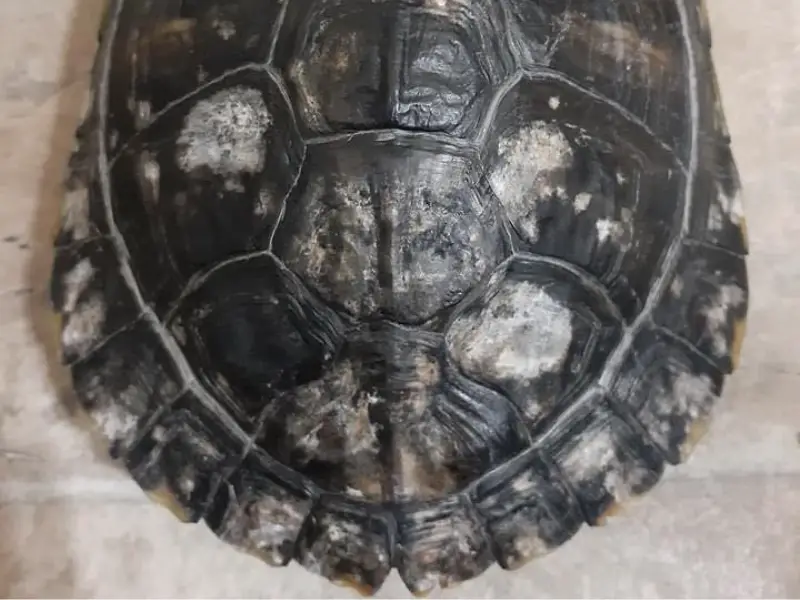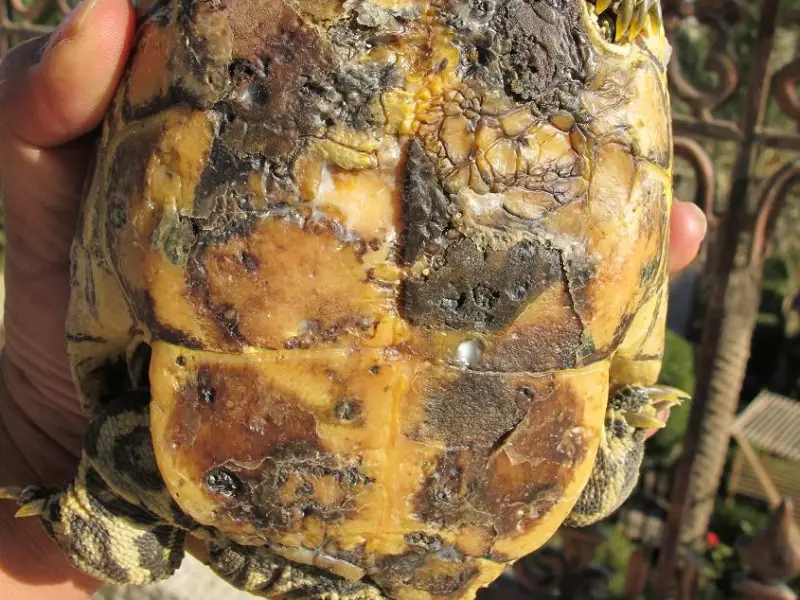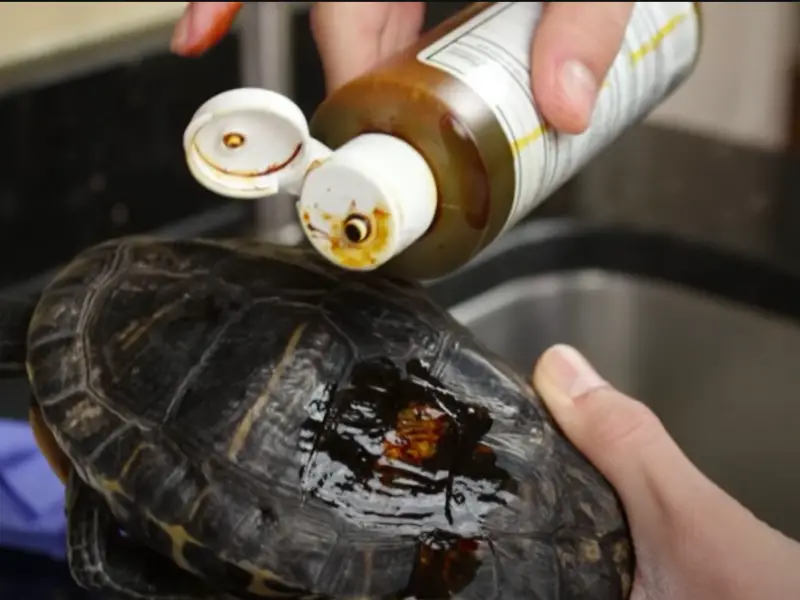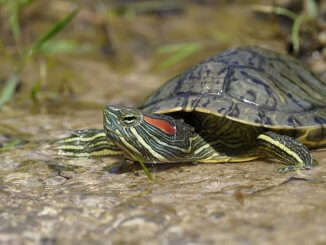
Shell rot is a condition that can affect both tortoises and turtles. If caught early, it can be managed fairly easily. However, it can become very severe and require serious medical intervention.
If left untreated, shell rot can kill turtles and tortoises.
Below, we’ll go over how to spot, treat and prevent shell rot, helping you to keep your turtle or tortoise healthy and happy.
Luckily, there are many things you can do to avoid and manage shell rot in your pets.
What Is Shell Rot?

Shell rot is a term that refers to ulcerative shell disease (USD), and can occur on either the carapace (top part of the shell) or the plastron (underside of the shell).
It eats away at the shell of your pet and causes deep abscesses. It can even result in whole shell plates coming off if it is left untreated.
What Causes Shell Rot?
The disease is caused by an inflection, but in order for that infection to take root, there needs to be a wound. This wound is almost always the result of environmental factors.
Shell Damage
So, the typical progression of shell rot is that there is some kind of damage to the shell.
This could be a cracking of the shell, some external damage, or a softening of the shell due to improper conditions.
Another cause of shell damage can be animals fighting each other. If you suspect that this is the case, make sure to separate the animals.
This is important to keep them safe, from shell rot and other damage.
Shell Cracking Due To Incorrect Humidity
In terms of cracking in the shell, this can occur if the enclosure where you keep your turtle or tortoise is too dry. Both turtles and tortoises require very specific levels of humidity and temperature to remain healthy.
For example, Box turtles respond well to around 65% humidity, whereas Sulcata and Leopard’s tortoises need a humidity of under 50% to be healthy.
On the other end of the spectrum, Yellow-foot tortoises are most comfortable in 80-95% humidity.
What this means is that you need to do a lot of research about the ideal conditions for your specific breed of turtle or tortoise before purchasing your pet.
On the other hand, if your enclosure is too humid or there is no space for your animal to fully dry off, then it is possible for the shell to soften, which can be a factor in ulcerative shell disease.
Environmental Factors
Other factors that can cause damage to the shell are sharp objects in the enclosure and a dirty environment.
Because the plastron is constantly on the ground, dirty conditions can easily contribute to infections in your animals.
Once there is any kind of damage to the shell, both tortoises and turtles become very vulnerable to bacterial and fungal infections.
Cracks or soft spots in the shell provide an entry point for bacteria and fungi.
This infection then causes the major symptoms of shell rot and is what results in potentially very serious consequences.
How To Identify Shell Rot

Fortunately, there are some very visible signs of shell rot, which means you can catch it early before it becomes a danger to your pet’s life.
Early Signs
The first sign to look out for is dents, holes, or pits in the shell. This is the external damage that leads to ulcerative shell disease. If you catch this early enough
The next symptom is whitish or gray spots on either the top or bottom half of the shell. These spots are normally round and localized, and can sometimes be mushy.
You should be able to see a clear contrast between these spots and the rest of the shell. It is important to regularly check your tortoise or turtle to ensure its health.
When checking the plastron, do not turn your pet upside down to check it.
Because a tortoise or turtle is completely vulnerable when upside down, it can lead to a great amount of stress for the animal.
You need to also look out for red or orange ulcers. In more severe cases, you might see thickening or flaking of the scutes (the plates that make up the shell).
Severe Symptoms
If your turtle or tortoise displays any of the following symptoms, it is a sign that the shell rot has progressed to a dangerous extent.
This means that you need to stop trying to treat it at home and rather get expert medical care from a vet.
These symptoms include a bad smell coming from the shell, and any sort of discharge, which can sometimes be bloody.
While serious symptoms in pets are often harder to spot, it is important to know what to look out for.
If you see any kind of reddish fluid under the shell plates or notice that the shell is becoming soft or slimy, it’s a sign of a serious problem.
Other symptoms to keep an eye out for are lifting or flaking plates on the shell and pus coming out from under the shell or swollen eyes.
You must also look out for behavioral changes. A sick turtle or tortoise is likely to be a bit less active, but serious lethargy is a cause for concern, as is not eating.
In very extreme cases, entire shell plates can fall off of your animal, exposing the vulnerable bones and nerves underneath. This poses a major health risk to your pet.
In very severe cases, this can also lead to a group of diseases called SCUD (Septicaemic cutaneous ulcerative diseases) where the infection enters the tortoise’s bloodstream and starts attacking the vital organs.
How To Treat Shell Rot

Once you suspect or are aware of shell rot, there is a clear treatment procedure that you can follow to treat the symptoms at home.
If you catch it early enough, these steps should help your pet to be back to normal in a few weeks.
Determine The Root Cause
Treatment is vital, but you also need to understand what resulted in this case of shell rot. Explore the animal’s enclosure and check for any contributing factors.
This includes things like a dirty enclosure, sharp objects, and incorrect temperature or humidity.
We break down some excellent ways to prevent ulcerative shell disease later on in the article because prevention is better (and easier) than cure.
Keep Wound Dry And Clean
The wound must be dried out before you can begin to treat it. This means removing the animal from any water.
You can clean the wound and surrounding shell with mild soap and a clean toothbrush. It is important to be gentle in this process.
Once the shell is clean and dry, you then need to scrape out the pits, which are the white or grayish spots.
You can use some kind of plastic tool, like a plastic card, to do this, after making sure that it is fully clean. Something plastic is ideal because it is gentler and less likely to cause accidental damage.
Use An Antiseptic And A Healing Cream
After this is complete, you need to disinfect the wound.
You may have seen online that you can use hydrogen peroxide to disinfect wounds on reptiles but do not do this!
Hydrogen peroxide is a harsh chemical that can damage healthy tissue.
Better options include things like a chlorhexidine solution or betadine. If you aren’t sure if what you have is safe to use, always consult a vet.
When you first start treating shell rot, you should disinfect the site a few times a day. Then apply a healing cream.
You can either go with an over-the-counter option like Neosporin or get a prescription for silver sulfadiazine.
Use UV Light
Sick turtles and tortoises require even more UV light to help them recover. They also heal faster when they are kept at a slightly warmer temperature.
So, make sure that your pet is getting several hours of basking time every day. Depending on the subspecies of turtle, they should bask for 2-8 hours per day.
On the other hand, tortoises should be basking for up to 12 hours.
Make sure that they are doing this basking directly under a UV light for maximum benefits while they are healing.
When your tortoise or turtle is in the healing phase, it can benefit from lower humidity as well.
A low humidity slows down microbial growth which can help prevent the shell rot from progressing faster. This gives you more time to treat it before it gets serious.
Repeat The Process
With turtles and tortoises, healing is a slow process, so you will need to repeat these steps for a week or two. Applying antiseptic and healing cream should be done a few times a day
While repeating this process, it is important to keep a photo log of your pet’s symptoms so that you can track the progression of the shell rot.
Having a photo log also means that you have clear evidence of whether there is improvement or worsening of the symptoms.
Make Sure Your Pet Eats
A sick tortoise is very likely to go off its food. However, when your pet is sick, it becomes even more important to make sure that they are eating properly.
In order for their body to fight off the infection and heal, they need to be receiving proper nutrition. Without this, your pet just won’t have the energy for its body to heal.
You should try to increase the amount it eats, or entice it with some treats. If you can’t manage it’sdiet at home, then you might need to use a feeding tube.
This can be done at home if you are an experienced reptile owner, otherwise, take your pet to the vet.
Taking Your Animal To The Vet
While there are a number of home remedies and ways for you to manage shell rot, it is also important to recognize when you need professional treatment.
If this is your first time owning a tortoise or turtle, it might be worth it to take your pet to the vet immediately to make sure that it gets the very best treatment.
However, if you are more experienced and catch the disease early, then you can likely treat it at home.
But if your animal starts showing severe symptoms, then you need to get emergency medical treatment for your pet.
In addition, if your pet does not respond to your at-home treatment after a week or two, it’s time to take it to the vet.
The most important thing is to prioritize the health and safety of your tortoise or turtle.
In severe cases, your tortoise or turtle may need to be sedated and undergo a process called debridement, where unhealthy tissue is removed, often under anesthesia.
This is a much more serious process than simply scrubbing the shell with a toothbrush.
If you are ever uncertain about the health of your pet, rather be safe than sorry and consult a vet.
When purchasing a turtle or tortoise, it is very important that you ensure you have access to a vet that will deal with exotic animals, as not all vets do.
How To Prevent Shell Rot
As with many things in life, prevention is better than cure. There are many ways that you can reduce your pet’s risk of developing ulcerative shell disease.
These things also contribute to an overall better quality of life for your tortoise or turtle.
Keep The Enclosure Clean
The first and most important way to prevent shell rot (and other diseases and infections) is to ensure that your pet’s habitat is always clean.
This includes constant monitoring of the conditions inside the enclosure, as well as a proper deep clean every week.
If things look dirty, clean them sooner rather than later. This is especially true if your turtles or tortoises are experiencing any other health conditions.
Manage Temperature And Humidity
Temperature and humidity are major contributing factors when it comes to shell rot. Make sure you have fully researched the conditions that are best for your chosen breed.
You also have to pay attention to the conditions under which your specific pet functions best.
Online resources can provide you with a good baseline, but you need to adjust those to the needs of your individual animal.
You also need to be aware of adjustments that need to be made as the season’s change and based on whether your pet hibernates or not.
Ensure There Is A Dry Area
It seems obvious that a tortoise needs a dry area, as they are land animals. But what people sometimes don’t realize is that a dry area is just as important for turtles.
This ties into the fact that not being able to dry off means that your pet is more likely to develop ulcerative shell disease because the wound is constantly moist.
Both turtles and tortoises require a dry area to bask in, allowing them to dry off completely. This is important not just in preventing shell rot but in the overall health of your beloved pet.
Have A Warming Light
UV warming lights are an important part of keeping your pet tortoise or turtle healthy.
This is because, as cold-blooded animals, they rely on external heat sources to manage their body temperature.
Providing a heating lamp means that they can use it to warm up, particularly in winter.
This also means that you can keep the enclosure as a whole at a reasonable ambient temperature, and allow your pet to alternate between warmer and cooler temperatures to regulate their bodies.
It is vital for turtles and tortoises to get a few hours of UV light per day. If your enclosure is inside, that means a UV light is non-negotiable.
Keep The Enclosure Safe
Your animals spend their lives in their enclosure, and you need to make sure that it is a safe and enriching space for your pet turtles or tortoises.
This means making sure that there are no sharp or jagged edges that they could cut themselves on.
You should do this before you even purchase your pets. However, it is also something you need to check consistently to make sure that no problems emerge.
Check Your Animal Regularly
This is one of the most important things that you can do. If you know what your pet tortoise or turtle looks like when they are healthy, it makes it a lot easier to see when something is wrong.
The best way to do this is to do regular checks on your pet, looking at both the carapace and the plastron, as well as their faces.
Doing this often allows you to pick up on any changes and catch any issues quickly. The earlier you can catch a problem, the easier it is to treat.
When it comes to shell rot, catching a wound early means that you can keep it clean and dry immediately, which can prevent the disease from even occurring.
But this also has major health benefits for your pet overall.
In Summary
Turtles and tortoises make fantastic pets, but they do require a lot of energy and effort to look after properly.
Make sure that you are ready for the commitment before getting one as a pet as they can live for many years when cared for properly.
If you do have a pet turtle or tortoise, then it’s very important to be aware of shell rot and its symptoms.
This will ensure that you can catch it early and treat it before it becomes serious so that your pet can remain happy and healthy.



